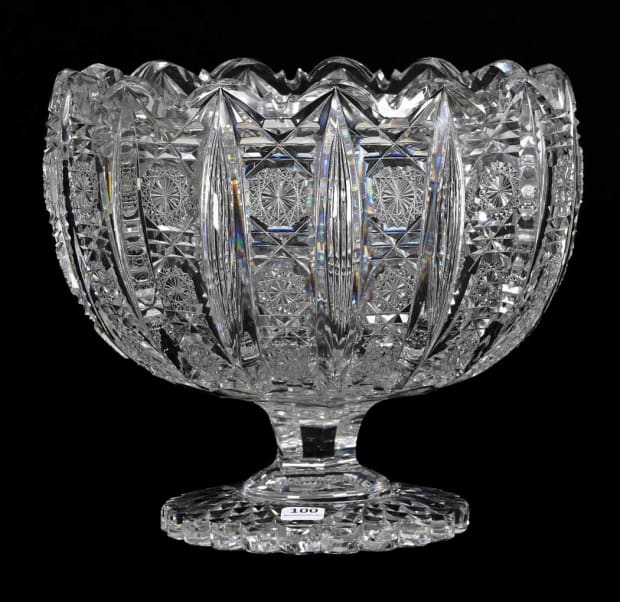#Rare #Punch #Bowl #Sparkles #Cut #Glass #Auction
Beautiful and often passed down as an heirloom, cut glass offers much for collectors and aficionados to appreciate as a unique form of art. With its handcrafted geometric designs, it exudes elegance and sparkles perfectly when reflecting light.
Collectors had nearly 380 lots of sparkling American brilliant cut glass to choose from when the exceptional collection of Nancy and Taylor Abernathy of Tennessee was sold at Woody Auction on Sept. 9.

Courtesy of Woody Auction.
The Abernathys, well-respected in the collecting community and as members of the American Cut Glass Association, assembled a collection deemed one of the best in both size and quality that encompassed an impressive array of rare and sought-after pieces.
Bidders were so eager to acquire these pieces that they pushed many far above estimates, including the top lot: a punch bowl with a Panel & Pillar pattern that sold for $33,600—more than three times its high estimate of $10,000. Made by T.G. Hawkes & Company, the extremely rare punch bowl is a single piece with a large scalloped Hobstar foot and weighs 16 pounds.

Courtesy of Woody Auction
Though cut glass dates to ancient times, the most popular with collectors today is the glass produced during the Brilliant Period, from approximately 1876 to 1914. Brilliant-cut glass made in America during this time was perhaps the finest in the world, fighting the belief that only Europe made the best glass. American companies, including T.G. Hawkes of Corning, New York, earned their stellar reputations at international exhibitions. At the 1889 Exposition Universelle in Paris, prizes were awarded to Hawkes, while the Libbey Glass Company of Toledo, Ohio, nabbed two medals at the 1893 World’s Columbian Exposition in Chicago.

There were over 70 pieces by Hawkes offered in the sale, which also included a trio of trays that sold well above their estimates: a round tray in the extremely rare Coronet Pattern that sold for $7,800, an ice cream tray in a Nautilus Pattern that sold for $5,400, and a round tray in a Panel Pattern that sold for $5,100—shattering its estimate of $300 to $500.
During the Brilliant Period, Libbey became the largest cut glass factory worldwide. The company was also well-represented in the auction with over 70 pieces, including the second and third top lots: a pedestal crescent vase in a Diana Pattern that sold for $22,800 (against an estimate of $7,500 to $12,500) and an incredibly rare tankard in an Aztec Pattern that also sold for $22,800 (against an estimate of $7,500 to $10,000).

Courtesy of Woody Auction
Two other pieces by Libbey in the Aztec Pattern rounded out the top five lots: an eight-pound round tray that sold for $19,200 (against an estimate of $7,500 to $10,000) and a tazza with a scalloped Hobstar foot that sold for $11,400 (against an estimate of $2,500 to $4,500).
Brilliant cut-glass pieces that have an outer layer of colored glass, called cut-to-clear, are also popular with collectors and bring high prices. Several colored glass pieces that sold included an emerald green cut-to-clear vase that fetched $9,600 (against an estimate of $2,000 to $3,000) and a cranberry cut-to-clear ship’s decanter that sold for $1,200.

Courtesy of Woody Auctions

Courtesy of Woody Auctions

Courtesy of Woody Auctions
